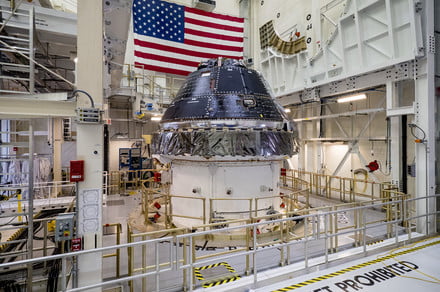NASA awarded Lockheed Martin the Orion Production and Operations Contract (OPOC), which tasks the company to design and prepare six to 12 Orion spacecraft in the next decade to go to the moon.
In a news release published on Tuesday, September 24, NASA announced the contract that will “focus on reusability and building a sustainable presence on the lunar surface.”
“This contract secures Orion production through the next decade, demonstrating NASA’s commitment to establishing a sustainable presence at the Moon to bring back new knowledge and prepare for sending astronauts to Mars,” said NASA Administrator Jim Bridenstine, in the press release. “Orion is a highly-capable, state-of-the-art spacecraft, designed specifically for deep space missions with astronauts, and an integral part of NASA’s infrastructure for Artemis missions and future exploration of the solar system.”
The contract lasts until September 30, 2030, and includes the production of a minimum of six and a maximum of 12 Orion spacecraft as part of NASA’s Artemis missions. Artemis III through V is valued at $2.7 billion, while the second batch of Artemis VI through VIII is valued at $1.9 billion.
The hope is for Orion to take the very first woman and the next man to the moon by 2024. The last people to set foot on the moon were Eugene “Gene” Cernan and Harrison “Jack” Schmitt during the Apollo 17 mission in December 1972.
NASA has been testing the Orion spacecraft to perfect it before the 2024 deadline.
A test in early August at White Sands Test Facility near Las Cruces, New Mexico, saw NASA put Orion’s propulsion system through its paces for a full 12 minutes in a simulation of what the space agency described as “one of the most taxing situations the spacecraft’s engines could encounter after launch.”
Aside from the Orion project, the contract with Lockheed Martin also supports the production of Gateway, NASA’s lunar-orbiting mission.
The decision to partner with Lockheed Martin to produce the Orion Spacecraft isn’t too much of a surprise since NASA announced several partnerships with companies back in July to advance commercial space and future NASA missions.
“We have learned a lot about how to design and manufacture a better Orion—such as designing for reusability, using augmented reality and additive manufacturing—and we’re applying this to this next series of vehicles. Driving down cost and manufacturing them more efficiently and faster will be key to making the Artemis program a success,” said Mike Hawes, Orion program manager for Lockheed Martin Space, in the company’s official statement.

